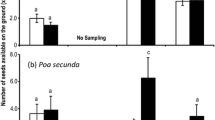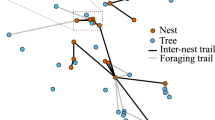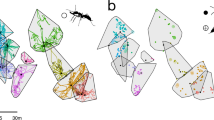Summary
Colonies of the harvester ant, Pogonomyrmex barbatus, adjust the direction and length of foraging trails in response to the foraging behavior of their conspecific neighbors. In the absence of any interaction with its neighbor, a mature colony expands its foraging range at a rate of 0.85 ± 0.15 m per day. Exclusion experiments show that if a colony is prevented from using its foraging trails, the neighbors of that colony will enter its foraging range within 10 days. Exclusion experiments were performed with three age classes of colonies: young (1 year old), intermediate (3–4 years old), and old (5 years old or more). Colonies 3–4 years old are most likely to expand foraging ranges, and to retain newly-gained areas. To examine the relation of colony age (in years) and colony size (in numbers of workers), colonies of known age were excavated. Colonies increase greatly in size in years 3 and 4. Foraging area may be of greater current or prospective value for younger, smaller, quickly growing colonies than for older, larger ones of stable size.
Similar content being viewed by others
References
Adams ES (1990) Boundary disputes in the territorial ant Azteca trigona: effects of asymmetries in colony size. Anim Behav 39:321–328
Alexander RD (1961) Aggressiveness, territoriality and sexual behaviour in field crickets (Orthoptera: Gryllidae). Behaviour 17:130–223
Beletsky LD, Orians GH (1987) Territoriality among male red-winged blackbirds. II. Removal experiments and site dominance. Behav Ecol Sociobiol 20:339–349
Beletsky LD, Orians GH (1989) Territoriality among male red-winged blackbirds. II. Testing hypotheses of territorial dominance. Behav Ecol Sociobiol 24:333–339
Brian MV (1973) Feeding and growth in the ant Myrmica. J Anim Ecol 42:37–53
Davies NB (1978) Territorial defence in the speckled wood butterfly (Pararge aegeria): the resident always wins. Anim Behav 26:138–147
Davidson DW (1978) Experimental tests of the optimal diet in two social insects. Behav Ecol Sociobiol 3:35–41
Engen S, Stenseth NC (1989) Age-specific optimal diets and optimal foraging tactics: a life-historic approach. Theor Pop Biol 36:281–295
Gordon DM (1986) The dynamics of the daily round of the harvester ant colony. Anim Behav 34:1402–1419
Gordon DM (1987) Group-level dynamics in harvester ants: young colonies and the role of patrolling. Anim Behav 35:833–843
Gordon DM (1989a) Ants distinguish neighbors from strangers. Oecologia 81:198–200
Gordon DM (1989b) Dynamics of task switching in harvester ants. Anim Behav 38:194–203
Gordon DM (1991) Behavioral flexibility and the foraging ecology of seed-eating ants. Am Nat 138:379–411
Gordon DM (1992) Nest relocation in the harvester ant, Pogonomyrmex barbatus. Ann Ent Soc Am 85:44–47
Gordon DM, Hölldobler B (1988) Worker longevity in harvester ants. Psyche 94:341–346
Greenslade PJM (1971) Interspecific competition and frequency changes among ants in Solomon Islands coconut plantations. J Appl Ecol 8:323–349
Hammerstein P (1981) The role of asymmetries in animal contests. Anim Behav 29:193–205
Holder Bailey K, Polis GA (1987) Optimal and central-place foraging theory applied to a desert ant, Pogonomyrmex occidentalis. Oecologia 72:440–448
Hölldobler B (1976) Recruitment behavior, home range orientation and territoriality in harvester ants, Pogonomyrmex. Behav Ecol Sociobiol 1:3–44
Hölldobler B (1978) The multiple recruitment systems of the African weaver ant Oecophylla longinoda (Latreille). Behav Ecol Sociobiol 3:19–60
Hölldobler B (1981) Foraging and spatiotemporal territories in the honey ant Myrmecocystus mimicus Wheeler. Behav Ecol Sociobiol 9:301–314
Hölldobler B (1983) Chemical manipulation, enemy specification and intercolony communication in ant communities. In Huber F, Markl H (eds) Neuroethology and Behavioral Physiology. Springer-Verlag, Berlin, pp 354–365
Hölldobler B, Lumsden CJ (1980) Territorial strategies in ants. Science 210:732–739
Hölldobler B, Wilson EO (1990) The ants. Harvard University Press, Cambridge
Kugler C (1984) Ecology of the ant Pogonomyrmex mayri: foraging and competition. Biotropica 16:227–234
MacKay WP (1981) A comparison of the nest phenologies of three species of Pogonomyrmex harvester ants. Psyche 88:25–75
MacKay WP (1985) A comparison of the energy budgets of three species of Pogonomyrmex harvester ants (Hymenoptera: Formicidae). Oecologia 66:484–494
Majer JD (1976) The influence of ants and ant manipulation on the cocoa farm fauna. J Appl Ecol 13:157–175
Maynard Smith J (1974) The theory of games and the evolution of animal conflicts. J Theor Biol 47:209–221
Maynard Smith J, Parker GA (1976) The logic of asymmetric contests. Anim Behav 24:159–175
Parker GA, Rubinstein DI (1981) Role assessment, reserve strategy, and acquisition of information in asymmetric animal conflicts. Anim Behav 29:221–240
Petrie M (1984) Territory size in the moorhen (Gallinula chlorapus): an outcome of RHP asymmetry between neighbors. Anim Behav 32:861–870
Porter SD, Tschinkel WR (1985) Fire ant polymorphism: the ergonomics of brood production. Behav Ecol Sociobiol 16:323–336
Reichert SE (1978) Games spiders play: behavioural variability in territorial disputes. Behav Ecol Sociobiol 3:135–162
Rissing SW, Pollock GB (1984) Worker size variability and foraging efficiency in Veromessor pergandei. Behav Ecol Sociobiol 15:121–126
Rissing SW (1988) Dietary similarity and foraging range of two seed-harvester ants during resource fluctuations. Oecologia 75:362–366
Rohwer S (1982) The evolution of reliable and unreliable badges of fighting ability. Am Zool 22:531–546
Ryti RT, Case TJ (1986) Overdispersion of ant colonies: a test of hypotheses. Oecologia 69:446–453
Schneirla TC (1971) Army ants. In: Topoff H (ed) Freeman, San Francisco
Schoener TW (1977) Theory of feeding strategies. Annu Rev Ecol Syst 2:369–404
Schoener TW (1983) Simple models of optimal feeding-territory size: a reconciliation. Am Nat 121:440–442
Stamps JA, Eason PK (1989) Relationships between spacing behavior and growth rates: a field study of lizard feeding territories. Behav Ecol Sociobiol 25:99–107
Stamps JA, Tollestrup K (1984) Prospective resource defense in a territorial species. Am Nat 123:99–114
Taber SW (1990) Cladistic phylogeny of the North American species complexes of Pogonomyrmex. Ann Entomol Soc Am 83:307–316
Taylor F (1977) Foraging behavior of ants: experiments with two species of myrmecine ants. Behav Ecol Sociobiol 2:147–167
Taylor F (1978) Foraging behavior of ants: theoretical considerations. J Theor Biol 71:541–565
Topoff H, Mirenda J (1980) Army ants on the move: relation between food supply and emigration frequency. Science 207:1099–1100
Traniello JFA (1989) Chemical trail systems, orientation and territorial interactions in the ant Lasius neoniger. J Insect Behav 2:339–353
Traniello JFA, Levings SC (1986) Intra- and intercolony patterns of nest dispersion in the ant Lasius neoniger: correlations with territoriality and foraging ecology. Oecologia 69:413–419
Wildermuth JL, Davis EG (1931) The red harvester ant and how to subdue it. USDA Farmer's Bull 1668:1–21
Author information
Authors and Affiliations
Additional information
Correspondence to the second address
Rights and permissions
About this article
Cite this article
Gordon, D.M. How colony growth affects forager intrusion between neighboring harvester ant colonies. Behav Ecol Sociobiol 31, 417–427 (1992). https://doi.org/10.1007/BF00170609
Received:
Accepted:
Issue Date:
DOI: https://doi.org/10.1007/BF00170609




